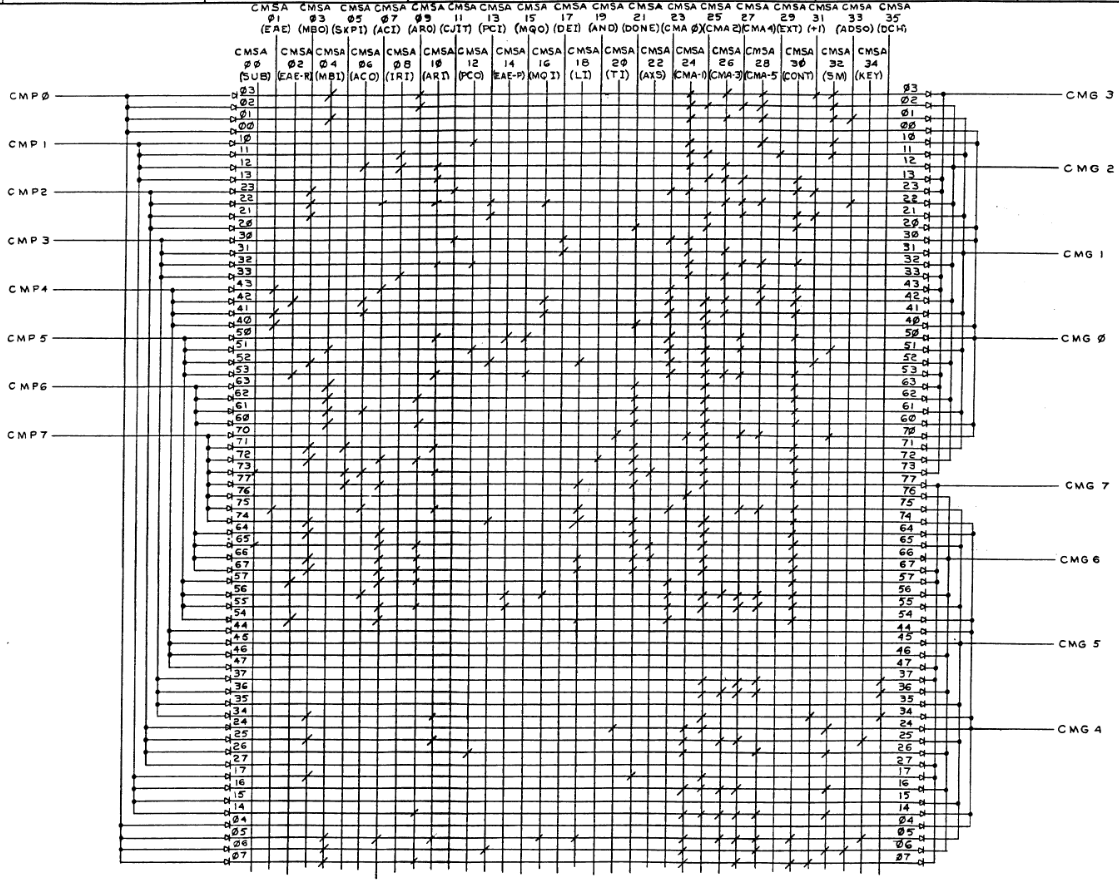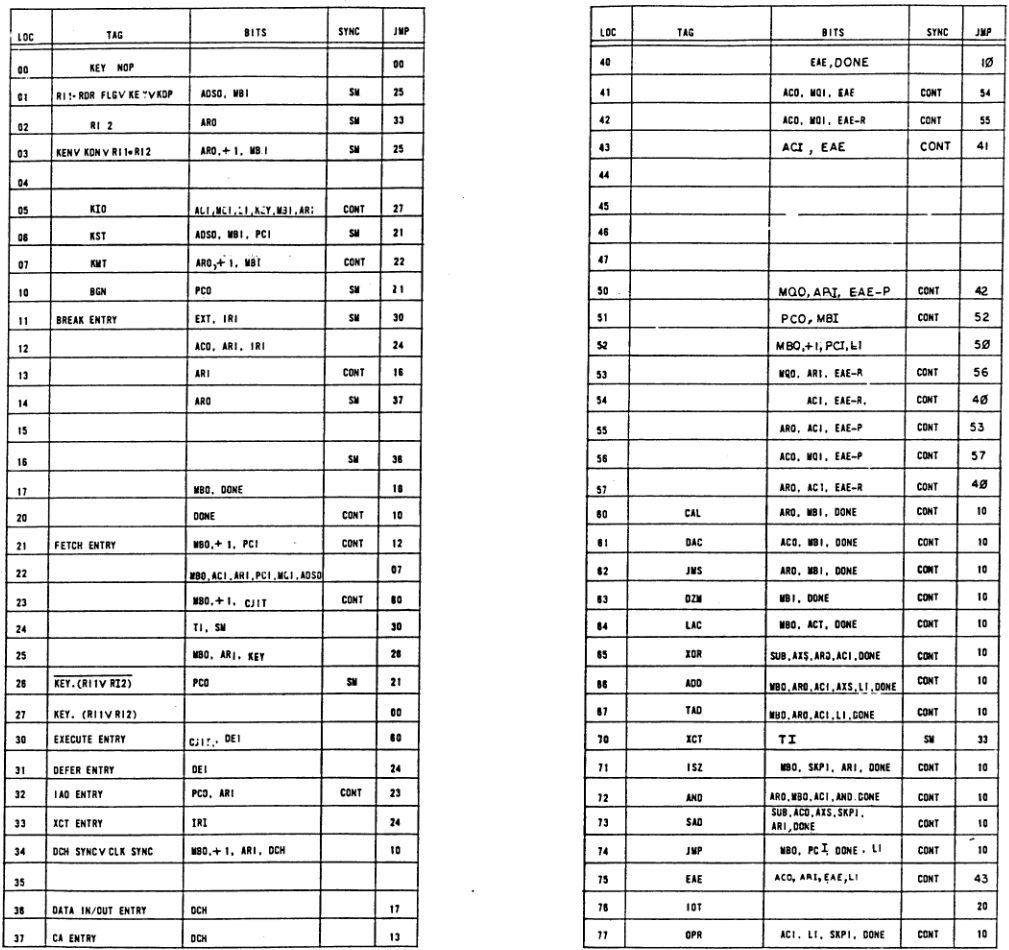Difference between revisions of "PDP-9 control memory"
From Computer History Wiki
(Explaining the instruction fetch-defer-execute flow.) |
(→Explanation: Pressing the START key.) |
||
| Line 238: | Line 238: | ||
===Explanation=== | ===Explanation=== | ||
| − | The start of the instruction flow is at CMA 10. All instructions end by looping back there. | + | When the machine is powered on, control memory loops in a "nop" word at CMA 00. When the START switch is pressed, the CMA is "boosted" to 06 by random logic decoding the state of the switches. |
| + | |||
| + | * 06: ADSO MBI PCI SM CMA/21<br>ADSO gates output from the address switches; MBI and PCI gates input to the MB and PC registers. CM starts memory acess. Processing enters in the middle of the fetch phase at CMA 21. | ||
| + | |||
| + | The normal start of the instruction flow is at CMA 10. All instructions end by looping back there. | ||
* 10: PCO SM CMA/21<br>PCO gates output from the PC register. Random logic sets MBI which gates input to the MB register, thus setting it to PC. SM starts memory access. | * 10: PCO SM CMA/21<br>PCO gates output from the PC register. Random logic sets MBI which gates input to the MB register, thus setting it to PC. SM starts memory access. | ||
Revision as of 08:36, 23 July 2023
Description of the PDP-9 control memory contents. The control memory is a read-only core memory which consists of 64 process words (i.e. microwords) of 36 bits each.
Contents
Wiring matrix
Program listing
Meaning of control bits
| Position | Name | Description |
|---|---|---|
| 00 | SUB | Subtract gate |
| 01 | EAE | |
| 02 | EAE-R | |
| 03 | MBO | Memory buffer output gate |
| 04 | MBI | Memory buffer input gate |
| 05 | SKPI | Skip input |
| 06 | ACO | Accumulator output gate |
| 07 | ACI | Accumulator input gate |
| 08 | IRI | Instruction regster input gate |
| 09 | ARO | Arithmetic register output gate |
| 10 | ARI | Arithmetic register input gate |
| 11 | CJIT | CAL/JMS/interrupt transfer gate |
| 12 | PCO | Program counter output gate |
| 13 | PCI | Program counter input gate |
| 14 | EAE-P | |
| 15 | MQO | Multiplier/quotient output gate |
| 16 | MQI | Multiplier/quotient input gate |
| 17 | DEI | Defer/execute initiate |
| 18 | LI | Link input gate |
| 19 | AND | AND instruction gate |
| 20 | TI | Test for indirect addressing |
| 21 | DONE | Instruction done gate |
| 22 | AXS | ADD/XOR/SAD instruction gate |
| 23-28 | CMA 0-5 | Address for next process word, possibly modified |
| 29 | EXT | External transfer gate (program break) |
| 30 | CONT | Continue to next process word |
| 31 | +1 | Increment the ADR |
| 32 | SM | Start memory cycle |
| 33 | ADSO | Address switches output gate |
| 34 | KEY | Key gate |
| 35 | DCH |
CMA modification
The control memory address, CMA, from process word bits 23-28 is heavily modified by random logic before being used for addressing the control memory.
- In address range 00-07 the CMA is OR'ed with a value that depends on the switches:
| Value | Switch |
|---|---|
| 1 | EXAMINE or DEPOSIT or READ IN |
| 2 | |
| 3 | EXAMINE NEXT or DEPOSIT NEXT or READ IN |
| 5 | IO RESET |
| 6 | START |
- CMA 30 from word 24 is OR'ed with 1 or 2 depending on the result of the TI control bit.
- Data channel requests will similarly "boost" the address.
- In address range 60-77, the lower four bits come from the upper four bits of the instruction register. Hence each process word in this range implements one of the 16 instructions.
Decoded to binary and symbolic form
| Address | Process word bits | Symbolic description |
|---|---|---|
| 00 | 000000000000000000000000000000000000 | CMA/00 |
| 01 | 000010000000000000000000101010001100 | MBI ADSO SM CMA/25 |
| 02 | 000000000100000000000000110110001000 | ARO SM CMA/33 |
| 03 | 000010000100000000000000101010011000 | MBI ARO +1 SM CMA/25 |
| 04 | 000000000000000000000000000000000000 | CMA/00 |
| 05 | 000010010010000010100000101110100010 | MBI ACI ARI MQI LI KEY CONT CMA/27 |
| 06 | 000010000000010000000000100010001100 | MBI PCI ADSO SM CMA/21 |
| 07 | 000010000100000000000000100100110000 | MBI ARO +1 CONT CMA/22 |
| 10 | 000000000000100000000000100010001000 | PCO SM CMA/21 |
| 11 | 000000001000000000000000110001001000 | IRI EXT SM CMA/30 |
| 12 | 000000101010000000000000101000000000 | ACO IRI ARI CMA/24 |
| 13 | 000000000010000000000000011100100000 | ARI CONT CMA/16 |
| 14 | 000000000100000000000000111110001000 | ARO SM CMA/37 |
| 15 | 000000000000000000000000000000000000 | CMA/00 |
| 16 | 000000000000000000000000111100001000 | SM CMA/36 |
| 17 | 000100000000000000000100010000000000 | MBO DONE CMA/10 |
| 20 | 000000000000000000000100010000100000 | DONE CONT CMA/10 |
| 21 | 000100000000010000000000010100110000 | MBO PCI +1 CONT CMA/12 |
| 22 | 000100010010010010000000001110000100 | MBO ACI ARI PCI MQI ADSO CMA/07 |
| 23 | 000100000001000000000001100000110000 | MBO CJIT +1 CONT CMA/60 |
| 24 | 000000000000000000001000110000001000 | TI SM CMA/30 |
| 25 | 000100000010000000000000101100000010 | MBO ARI KEY CMA/26 |
| 26 | 000000000000100000000000100010001000 | PCO SM CMA/21 |
| 27 | 000000000000000000000000000000000000 | CMA/00 |
| 30 | 000000000001000001000001100000000000 | CJIT DEI CMA/60 |
| 31 | 000000000000000001000000101000000000 | DEI CMA/24 |
| 32 | 000000000010100000000000100110100000 | ARI PCO CONT CMA/23 |
| 33 | 000000001000000000000000101000000000 | IRI CMA/24 |
| 34 | 000100000010000000000000010000010001 | MBO ARI +1 DCH CMA/10 |
| 35 | 000000000000000000000000000000000000 | CMA/00 |
| 36 | 000000000000000000000000011110000001 | DCH CMA/17 |
| 37 | 000000000000000000000000010110000001 | DCH CMA/13 |
| 40 | 010000000000000000000100010000000000 | EAE DONE CMA/10 |
| 41 | 010000100000000010000001011000100000 | EAE ACO MQI CONT CMA/54 |
| 42 | 001000100000000010000001011010100000 | EAE-R ACO MQI CONT CMA/55 |
| 43 | 010000010000000000000001000010100000 | EAE ACI CONT CMA/41 |
| 44 | 000000000000000000000000000000000000 | CMA/00 |
| 45 | 000000000000000000000000000000000000 | CMA/00 |
| 46 | 000000000000000000000000000000000000 | CMA/00 |
| 47 | 000000000000000000000000000000000000 | CMA/00 |
| 50 | 000000000010001100000001000100100000 | ARI EAE-P MQO CONT CMA/42 |
| 51 | 000010000000100000000001010100001000 | MBI PCO SM CMA/52 |
| 52 | 000100000000010000100001010000010000 | MBO PCI LI +1 CMA/50 |
| 53 | 001000000010000100000001011100100000 | EAE-R ARI MQO CONT CMA/56 |
| 54 | 001000010000000000000001000000100000 | EAE-R ACI CONT CMA/40 |
| 55 | 000000010100001000000001010110100000 | ACI ARO EAE-P CONT CMA/53 |
| 56 | 000000100000001010000001011110100000 | ACO EAE-P MQI CONT CMA/57 |
| 57 | 001000010100000000000001000000100000 | EAE-R ACI ARO CONT CMA/40 |
| 60 | 000010000100000000000100010000100000 | MBI ARO DONE CONT CMA/10 |
| 61 | 000010100000000000000100010000100000 | MBI ACO DONE CONT CMA/10 |
| 62 | 000010000100000000000100010000100000 | MBI ARO DONE CONT CMA/10 |
| 63 | 000010000000000000000100010000100000 | MBI DONE CONT CMA/10 |
| 64 | 000100010000000000000100010000100000 | MBO ACI DONE CONT CMA/10 |
| 65 | 100000010100000000000110010000100000 | SUB ACI ARO DONE AXS CONT CMA/10 |
| 66 | 000100010100000000100110010000100000 | MBO ACI ARO LI DONE AXS CONT CMA/10 |
| 67 | 000100010100000000100100010000100000 | MBO ACI ARO LI DONE CONT CMA/10 |
| 70 | 000000000000000000001000110110001000 | TI SM CMA/33 |
| 71 | 000101000010000000000100010000100000 | MBO SKPI ARI DONE CONT CMA/10 |
| 72 | 000100010100000000010100010000100000 | MBO ACI ARO AND DONE CONT CMA/10 |
| 73 | 100001100010000000000110010000100000 | SUB SKPI ACO ARI DONE AXS CONT CMA/10 |
| 74 | 000100000000010000100100010000100000 | MBO PCI LI DONE CONT CMA/10 |
| 75 | 010000100010000000100001000110100000 | EAE ACO ARI LI CONT CMA/43 |
| 76 | 000000000000000000000000100000000000 | CMA/20 |
| 77 | 000001010000000000100100010000100000 | SKPI ACI LI DONE CONT CMA/10 |
Explanation
When the machine is powered on, control memory loops in a "nop" word at CMA 00. When the START switch is pressed, the CMA is "boosted" to 06 by random logic decoding the state of the switches.
- 06: ADSO MBI PCI SM CMA/21
ADSO gates output from the address switches; MBI and PCI gates input to the MB and PC registers. CM starts memory acess. Processing enters in the middle of the fetch phase at CMA 21.
The normal start of the instruction flow is at CMA 10. All instructions end by looping back there.
- 10: PCO SM CMA/21
PCO gates output from the PC register. Random logic sets MBI which gates input to the MB register, thus setting it to PC. SM starts memory access. - A new memory cycle starts, reading MB into MA.
- 21: MBO +1 PCI CONT CMA/12
MBO puts MB into the adder, and +1 increments the address by one. The sum is put into PC. - The read portion of the memory cycle is now ready. Random logic sets SAO and MBI, which transfers data from the memory SA "sense amplifiers" to MB.
- 12: IRI ACO ARI CMA/24
IRI sets the IR register from SA. ACO and ARI copies the accumulator contents to the AR register. - 24: TI SM CMA/30
TI makes a check for indirect addressing. SM starts a new memory access to retrieve the instruction operand. - A new memory cycle starts.
- At this point, CMA 30 may be "boosted" by random logic. If there's indirect addressing, processing continues at CMA 31. If the IR holds a CAL, DAC, JMS, or DZM instruction, processing continues at 32. Otherwise, proceed to the unboosted address 30.
- 30: DEI CJIT CMA/60
DEI ensures MBI and SAO are set to retrieve the memory operand. CJIT activates a check for ISZ with operand 0, and increments the PC if so. The next CMA is "boosted" by putting the instruction opcode in the lower four bits, thus dispatching to CMA 60-77. - 31: DEI CMA/24
DEI clears the indirect addressing bit, and processing loops back to CMA 24 to start a new memory cycle using MB as the address. - 32: ARI PCO CONT CMA/23
The PC is saved in the AR register for the benefit of CAL and JMS.
23: MBO CJIT +1 CONT CMA/60
MBO sends the MB through the adder, and +1 increments it. CJIT checks for CAL or JMS to set PCI and store the incremented result the PC. Dispatch to CMA 60-77.
- 30: DEI CJIT CMA/60
- The instuction execute phase dispatches to the CMA region 60-77. Three instructions, XCT, EAE, and IOT, have a more complicated flow.
- 60-77: [various] DONE CONT CMA/10
Most instructions do their thing and loop back to CMA 10. - XCT 70: TI SM CMA/33
Start a new memory access to fetch the instruction.
33: IRI CMA/24
Put the opcode in IR and loop back to CMA 24. - EAE 75: EAE ACO ARI LI CONT CMA/43
Extended arithmetic is implemented in CMA 40-57 and will eventually reach a process word with DONE CONT CMA/10. - IOT 76: CMA/20
Random logic does all the work for the I/O transfer instructions.
20: DONE CONT CMA/10
Finish I/O and loop back to CMA 10.
- 60-77: [various] DONE CONT CMA/10

